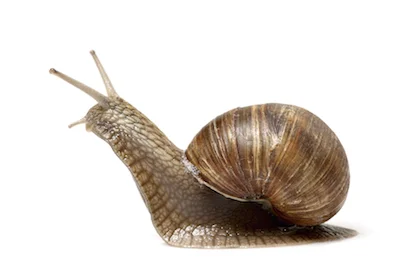A snail has a soft, slimy body.
It has a hard shell to protect the body.
The snail can pull its body inside the shell.
Its eyes are on the end of two tall stalks on its head.
Inside the soft body is a muscle called a foot.
The foot ripples and moves the snail along.
Snails belong to a family of animals called molluscs.
Most kinds of snail are sea animals, many are land animals, some are freshwater animals. Most are herbivores but some are omnivores (eat meat and plants).
Snail. Photo©iStock
There are many species, or kinds, of snail. Their shells are different shapes. Land snails can be found in almost every kind of habitat, including deserts, mountains, wetlands, forests and gardens. The biggest land snail is the Giant African snail, which can grow up to 30 cm in length. The biggest freshwater snail is the Giant Apple snail, which can grow to 15cm in length and 600g in weight. The biggest of all snails is an Australian sea snail that can grow to a length of over 77 cm and a weight of 18 kg.
Snail Body
Snails have a soft body, protected by a hard shell. When threatened, a snail pulls itself inside its shell.
The snail's foot can be seen inside the body. Photo©iStock
On a snail's head there are two pairs of tentacles. The snail's eyes are located on the top of the longer tentacles. The shorter tentacles are used for smelling and feeling its way.
A snails breathes through its skin and through a small hole on its right side, just below its head.
Inside a snail's body there is a muscle called a foot, and this propels the snail. The snail's body is kept moist by mucus, and that helps the snail to glide along as the foot ripples. The mucus that the snail produces helps its movement and reduces the risk of injury from sharp objects. When snails pull their bodies into their shells, they can close a door-like part of the shell called an operculum. They do this in dry weather, in order to prevent the body from drying out.
Inside a snail's mouth is a radula for grinding food. It's a bit like a file, and is used to scrape leaves and flowers as they eat them. Teeth are in rows on the radula. As the front teeth are worn down, a new row of fresh teeth replaces the old one.
Snail seen from above. Photo©iStock
Life Cycle
Snails are hermaphrodites(say: her-maf-roe-dites). This means that each snail has a female part which lays eggs and a male part which makes sperm. When two snails mate, each snail presses the front part of its foot against the foot of the other snail. The snails shoot a hard dart into each other, which makes sperm pass between them. However, a single snail can do all this by itself! The sperm will make the eggs each snail lays, grow into baby snails.
About two weeks after mating, the snail scrapes a hole in the soil and lays its eggs there. A snail lays between 20 and 50 eggs at a time. The eggs are covered up and they hatch after about four weeks.
As a snail grows its shell grows too. Snails are related to slugs. There are more than 7000 species of snails and slugs. Snails eat plants with their tongues. There are thousands of tiny teeth on a snail's tongue, or radula. A snail also grinds up small pieces of rock with its radula to get minerals it need for a strong healthy shell.
Birds and many other animals eat snails. Photo©iStock
Some snail facts:
As a snail grows its shell grows too
Snails hibernate in winter.
They can mate when they are about one year old.
Snails are related to slugs.
There are more than 7000 species of snails and slugs.
Snails can live for one or two years.
It is always a good idea to use more than one source of information, so here are some others for you to investigate
Read more about snails:
http://www.sciencekids.co.nz/sciencefacts/animals/snail.html






